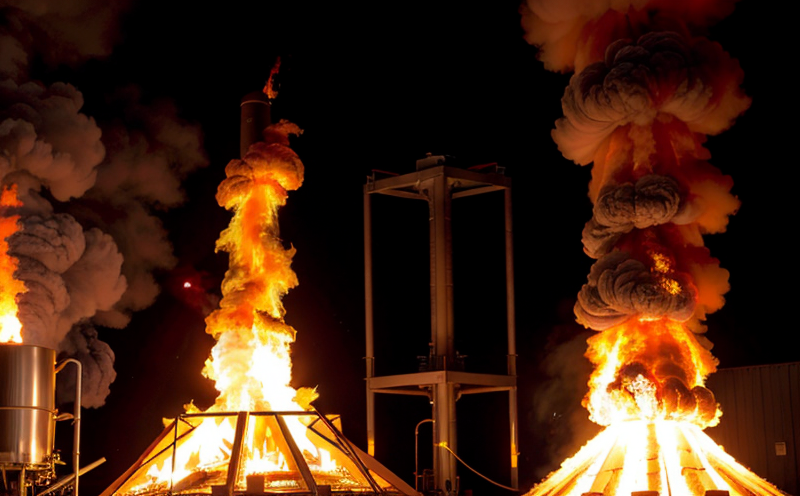Laminated Board Flammability Testing
Flammability testing of laminated boards is a critical component in ensuring product safety and compliance with international standards. Laminated boards, especially those found in electronic devices, building materials, and furniture, are exposed to various environmental conditions that could potentially lead to ignition or fire hazards. This test evaluates the combustibility properties of these materials under controlled laboratory conditions. The purpose is to identify any potential risks associated with the material's flammability and determine compliance with relevant safety standards.
The testing process involves exposing a representative specimen to a specific heat source for a defined period, observing its behavior, and measuring key parameters such as flame spread rate and smoke production. This information helps in assessing the ignition properties of the laminated board, including its self-extinguishing ability once the heat source is removed.
The results of flammability tests are essential for product developers to refine their materials and processes, ensuring that they meet regulatory requirements and enhance consumer safety. Compliance with standards such as UL 94 (for plastic materials), ISO 13522-1 (for textiles and other non-plastic items), or EN 60695-11-10 (electrical equipment) is crucial for market entry in many countries.
Understanding the flammability characteristics of laminated boards helps manufacturers address various challenges, including ensuring product safety, reducing liability risks, and enhancing brand reputation. By conducting rigorous testing, companies can identify potential areas for improvement and implement measures to mitigate any identified hazards.
- UL 94: This standard evaluates the ignition properties of plastics under specific conditions. It includes several classifications based on the distance from which a small flame is applied to the specimen.
- ISO 13522-1: Used for testing the flammability of textiles and other non-plastic items, this standard provides a method for assessing the burning characteristics of materials under controlled conditions.
- EN 60695-11-10: This European standard addresses the flammability requirements for electrical equipment. It specifies test methods to evaluate the self-extinguishing properties of materials when exposed to a flame.
The competitive advantage in performing rigorous flammability testing lies in the ability to identify potential risks early on and make informed decisions about material selection and design modifications. This proactive approach not only enhances product safety but also ensures compliance with stringent international standards, thereby reducing the risk of recalls and litigation.
Why It Matters
The importance of flammability testing for laminated boards cannot be overstressed in today's global market. Product safety is paramount, especially when dealing with materials that come into contact with human environments or are used in hazardous conditions. Non-compliance with relevant standards can lead to severe consequences, including product recalls, legal actions, and reputational damage.
Moreover, stringent regulatory requirements make it essential for manufacturers to have robust testing protocols in place. Failure to meet these standards could result in the denial of market access or even the suspension of business operations. By conducting thorough flammability tests, companies can ensure that their products are safe and reliable, thereby protecting both consumers and the environment.
In addition to regulatory compliance, flammability testing also plays a crucial role in product development and innovation. It allows engineers to refine materials and processes, leading to safer and more efficient products. This is particularly important for industries such as electronics, construction, and automotive, where safety is a key consideration.
Applied Standards
The flammability testing of laminated boards follows specific standards that are widely recognized in the industry. These include:
- UL 94: This standard evaluates the ignition properties of plastics under various conditions, including V-0, V-1, and V-2 classifications.
- ISO 13522-1: Used for textiles and other non-plastic items, this standard provides a method for assessing burning characteristics in controlled environments.
- EN 60695-11-10: This European standard addresses the flammability requirements of electrical equipment. It specifies test methods to evaluate self-extinguishing properties when exposed to flames.
- ASTM E84: Known as the "Smoking Torch Test," this method evaluates the smoke obscuration and flame spread characteristics of materials used in building construction.
- EN 13501-1/2: This European standard covers the classification of products based on their flammability, particularly for materials used in buildings.
These standards provide a framework for testing and evaluating the flammability properties of laminated boards. Compliance with these standards ensures that products meet international safety requirements and are suitable for use in various applications.
Competitive Advantage and Market Impact
Conducting thorough flammability testing offers significant competitive advantages in today's market:
- Innovation Leadership: By identifying potential risks early, companies can innovate safer products that meet the highest safety standards.
- Compliance with Regulations: Ensuring compliance reduces the risk of legal issues and product recalls, enhancing brand reputation.
- Enhanced Consumer Trust: Safe products build trust among consumers, leading to increased market share and customer loyalty.
- International Market Access: Compliance with global standards opens doors to international markets, expanding business opportunities.
- Risk Mitigation: Early identification of risks minimizes potential losses due to accidents or non-compliance issues.
- Innovation and Sustainability: By testing for flammability, companies can incorporate sustainable practices that enhance both safety and environmental impact.
Overall, comprehensive flammability testing not only ensures product safety but also contributes to a safer environment while enhancing market competitiveness. By prioritizing these tests, manufacturers can stay ahead of the curve in an increasingly safety-conscious world.





